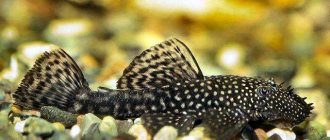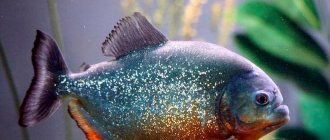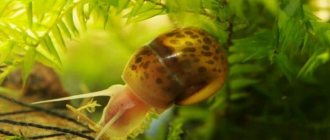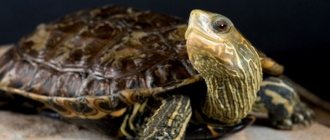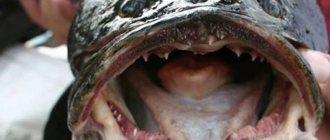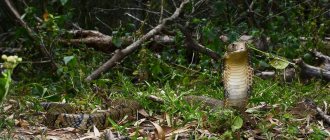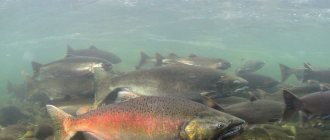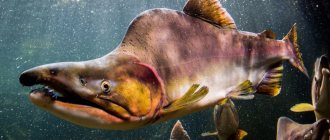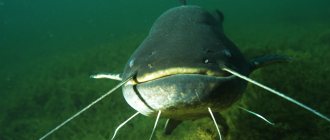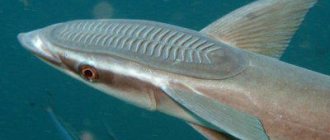The snake fish, or as it is also called - Kalamoicht Calabar, is an unusual underwater inhabitant. This ancient fish has a serpentine appearance and elegance, moves differently than other fish, is more active at night and needs shelter. And although these unique individuals have adapted well to life in captivity, they have not gained widespread popularity among aquarists. Is it difficult to keep Kalamoichta Calabar at home, and what should future owners know about these pets?
Maintenance and care
Kalamoikhtas breathe atmospheric air, so you should not worry too much about aeration of the aquarium if only this type of fish lives in it.
An air plug left above the surface of the water will be enough to satisfy their need for oxygen. The lid of the aquarium should be tight and without holes, as due to its curious nature the fish can easily get out.
Kalamoichts are fish accustomed to life in natural bodies of water. This is worth considering when choosing an aquarium, soil, plants and shelters for your future pet.
A snake accustomed to the wide river expanses of West Africa will be comfortable in an aquarium with a volume of 100 liters or more.
Due to living in turbid river water, the Calabar calamoichta's vision is poorly developed, so the main senses are touch and smell.
It is advisable to use sand or fine gravel as the soil, simulating a river bottom.
It is recommended to bury the roots of plants deeper into the gravel and press them down with stones to protect them from damage when the fish swarms in the ground.
The gravel layer should be 3-5 cm. Kalamoihts will gratefully accept a variety of shelters and burrows that the owner will create for his pets from stones, driftwood or artificial castles from pet stores. There they feel safe and comfortable.
Water temperature should be within 22-28°C, pH 6.5-7.5, gH 2-15
It is very important to keep all indicators stable, since the fish is very sensitive to changes in the hydrochemical composition of the water
Do not neglect filtration and weekly replacement of 1/5 of the water. During the adaptation period or during an emergency shift, Biotopol, Stresscoat or JblAcclimol conditioners can be used.
During treatment, fish do not tolerate formaldehyde, excessive salting of water and organic dyes.
Snake fish habitat
The habitat of the species Erpetoichthys calabaricus stretches from the mouth of the Ogun River in Nigeria to the Shiluango River in the Congo, the city of Brazzaville, Republic of the Congo. Individuals inhabit fresh or brackish slow-flowing rivers or bodies of standing water. Apparently, the kalamoichta biotope is overgrown with reeds.
The fish move along the bottom, making snake-like movements, as well as moving sideways. Being an amphibious fish, the kalamoicht has paired pulmonary sacs (formations from the swim bladder), the lumen of which is located in the esophagus. One research study determined the involvement of gills, lung sacs and skin in the respiration of snake fish.
The studied individuals were placed in a special chamber. It has been shown that in terms of oxygen consumption, the lung sacs account for 40%, the gills account for 28%, and the skin accounts for 32%. Thus, the kalamoicht is able to breathe atmospheric air and stay on land for a short time.
History of Kalamoicht
This amazing snake fish was first presented in 1906, in Europe, at an exhibition of aquarium animals held in Magdeburg. The “Aquarium” of the Stockholm ethnographic park “Skansen” donated 4 copies of the Calabar Kalamoichta to the “Aquarium” of the Moscow Zoo in 1984. And only 20 years after this, Kalamaicht confidently took the position of a common aquarium resident.
Established over 40 million years ago. years ago, the Calabar Kalamaicht today is almost no different in appearance from its ancestors Cladistia, which are considered one of the most ancient fish on our planet. The past centuries of evolution have left the modern specimen with only pectoral fins, almost completely excluding the pelvic fins, or moving them as far as possible to the tail, crowned with small dorsal spines.
Many scientists are interested in this type of fish because, according to numerous theories, it is from such creatures that the modern inhabitants of our planet originated. Being a completely aquatic inhabitant, Kalamoicht has lungs, which are two equal lung sacs, similar in structure to the lungs of many mammals and not at all similar in structure to the respiratory system of many fish.
There are versions, theories that in the process of evolution, some of the fellow kalamoichtas grew limbs and came to land.
VIDEO
Peculiarities of breathing of snake fish
Kalamoicht is an amphibious fish with paired pulmonary sacs - formations from the swim bladder. Their lumen is located in the digestive canal. Studies of these fish have shown that they use gills, lung sacs and skin to breathe. To find out, the individuals were placed in special chambers. Oxygen enters the body as follows:
- 40% - through the pulmonary sacs;
- by 28% - through the organs of water respiration - gills;
- by 32% - through the skin.
Nature made sure that calamoikhtas not only lived in water, but could also inhale atmospheric air and even spend some time on land. The larvae and juveniles have external gills, which make individuals resemble juvenile salamanders.
Care and maintenance
The aquarium fish, similar to a snake, is very inquisitive and has a rather peaceful disposition. Despite its appearance, it can scare even the smallest inhabitants of an artificial reservoir. It emerges from shelter mainly at night, but can be active during the daytime if it is simply fed.
Guppy fish cannot be neighbors for snake fish
Plants planted in an artificial reservoir need additional strengthening, since the kalamoicht, which lives at the bottom, loves to dig into the soil, which is why the root system suffers greatly. Use only soft soil, as aquarium snakes like to burrow in it and, if chosen poorly, can damage their scales. The best option would be fine, smooth gravel or sand. You can plant Aponogeton, Anubias or Vallisneria at the bottom of the aquarium.
Basic content requirements:
- The aquarium must have a volume of at least 100 liters and a tight lid.
- The average water temperature is 25 degrees, its hardness should be from 2 to 17, acidity - 6.1-7.6.
- A prerequisite is the presence of many grottoes, stones and other shelters - the fish must feel safe.
In this case, it is necessary to monitor the tightness of the lid and promptly eliminate any cracks that appear. Kalamoihts are very inquisitive and will try to escape at the first opportunity. They are able to travel long distances on land, but cannot remain without water for a long time. Avoid sharp fluctuations in hydrochemical parameters of water. If it is necessary to urgently replace the fluid, it is necessary to use special conditioners that will help quickly restore the required performance. The most popular of them are the following:
- Stresscoat;
- Biotopol;
- Acclimol.
Snake fish prefer live protein foods
Food kalamoichta
Calamoichtas, unlike most other fish species, have an excellent sense of smell. When it comes to food, they prefer live and protein-rich foods. For example, they can be given pieces of frozen food or shrimp, fish fillets, earthworms or small worms, brine shrimp, squid, and bloodworms.
Reproduction of snake fish
The female can be distinguished from the male by her drooping abdomen and light yellowish-olive anal fin (it is usually darker in males). In addition, males have 12-14 dorsal fins, while females have only 9-12, otherwise they are no different from each other.
Unfortunately, snake fish are not able to reproduce in captivity, with the exception of isolated cases, since it is almost impossible to artificially create conditions that coincide with natural ones. Kalamoikhta are bred on special farms or caught in natural conditions.
Snakefish are an excellent option for aquarists. It compares favorably with other inhabitants of an artificial reservoir with its unusual shape, coloring and behavior.
https://youtube.com/watch?v=xj32Yhb0OWw
Reproduction
The female differs from the male in having a slightly drooping abdomen and anal fins that are much lighter than males, usually of a yellowish-olive hue. Also, females have 9–12 dorsal fins, while males have 12–14. There are no other external signs of difference between a female and a male.
The saddest thing is that calamoikhtas do not reproduce in captivity. More precisely, this happens very rarely, and few people can achieve such ideal conditions for them. They are caught in nature or bred on farms where special hormones are used.
Keeping in an aquarium
Kalamoikhta should be kept in large aquariums.
The fact is that the fish can grow quite large and require a lot of space for swimming.
Adults should be kept in aquariums with a volume of at least 200 liters.
Although they are predominantly nocturnal, with regular feeding during the day they become accustomed and become more active during the day.
But at the same time, kalamoichtas are rather timid fish, even shy
It is important to create shelters for them in which they can hide during the day and hide in case of persecution
You also need soft soil, without sharp edges.
Calamoikhtas can burrow into the ground and it is important that they do not damage their scales
Remember that calamoichts can easily escape from the aquarium; it is important to tightly close all possible cracks. They can get through gaps that seem impossible to crawl through and travel quite long distances on land.
They tolerate neutral or slightly acidic water well, with a pH of 6.5 - 7.5. Water temperature 24-28C. In nature, Calabar calamoichts are sometimes found in slightly salty water, for example in river deltas.
Because of this, it is believed that they love salt water, but unlike other types of fish living in salt water, calamoikhtas do not tolerate high salt content. Preferably no more than 1.005.
It is important to remember that calamoikhtas will hunt fish that they can swallow. Must be kept with medium to large fish, such as synodontis, cichlids or large characindas
They get along with such fish without problems and are peaceful. Neons, barbs, shrimp, small catfish are hunted, so don't be surprised if they disappear.
Habitat
Calabar calamarithus (Erpetoichthys calabaricus) distribution areas.
Africa - inhabits small, slow-flowing rivers and stagnant bodies of water. Widely distributed in West Africa, caught in the Democratic Republic of the Congo, Angola, Nigeria, Cameroon, Equatorial Guinea, Benin. As a rule, it lives in shallow waters, in waters with dense vegetation.
Calabar calamarithus (Erpetoichthys calabaricus) habitats.
Snake fish behavior
https://www.youtube.com/watch?v=sD1xSsG0n6E
When choosing a company for such original pets, you should immediately exclude small-sized inhabitants - they will consider individuals that fit into the mouth of snake fish only as food. You can house snakes:
- carp;
- characins;
- cichlids;
- soms;
- angelfish;
- tilapia;
- severums;
- synodontis.
But you can limit yourself to the inhabitants of only one species; calamoikhtas are not aggressive and non-territorial, they coexist perfectly with their fellows.
The Calabarian is active both at night and during the day. The snake-like fish can calmly stay near the walls of the aquarium, watching what is happening through the glass. While searching for food, she shows particular ingenuity - she gradually narrows her circles until she stumbles upon food, or digs it out from under pebbles and sand.
Kalamoicht calabar is an exotic and incredibly interesting aquarium fish, characterized by its unpretentiousness and calm character, thanks to which even a novice aquarist who wants to acquire an unusual pet can cope with its maintenance.
Is it worth waiting for offspring?
Kalamoicht: maintenance does not affect the desire to reproduce. Unfortunately. To stimulate reproductive function, hormone injections are required, the implementation of which requires skill and experience. If the stimulation is successful and reproduction is urgent, neither the male nor the female are caring parents and do not care for the eggs, and subsequently the fry. The reproductive process ends with the laying of eggs and their fertilization. However, there are practically no cases of breeding offspring in aquariums.
Today, pet stores almost always have a wide selection of underwater inhabitants. However, it is unlikely that they will offer to buy a kalamoicht. Firstly, the specific appearance, and secondly, the features of the content. But for those who understand and appreciate the specificity and originality of such an individual, it will be easy and interesting to work with her. And most importantly, never be bored and positive!
Post Views: 5,337
Compatibility with other fish
Snake fish should not be large in size, but they should not be smaller than their “neighbors.” An excellent company for them are cichlids, catfish or sonodontis.
You also need to know that you shouldn’t add too active fish to them. Otherwise, they will take away all the food from the snake-like creatures. And, conversely, small fish may end up in their stomach. These include tadpoles, small catfish or newts. In addition, snake fish can eat neon as well as zebrafish. As for the kalamoichta, it is capable of eating even its own kind, only smaller in size.
If such fish are kept in communal aquariums, fights over food may even occur. To prevent this from happening, the aquarium must be large and have enough food for everyone. Most often they are settled in 4-5 individuals in one container.
Those who choose to keep such unusual fish should definitely be familiar with all the recommendations for keeping them.
In the next video you can watch the Calabar calamoicht while feeding.
Today there are many varieties of aquarium fish. Of course, already known species are more popular. For example, these are cockerels, swordtails, guppies, angelfish, golden ones, barbs, various catfish, etc. All of them are known to almost any person, even if he has nothing to do with aquariums. They can be found in every pet store. But sometimes a more experienced aquarist wants something unusual, more interesting.
Of course, it is not easy to find a fascinating representative of the underwater fauna, but they can still be found in Russia. For example, this includes the kalamoicht, which is also called the snake fish.
basic information
Snakefish are not often found in private aquariums. Only a small number of enthusiasts are engaged in their breeding. However, individuals are often found in pet stores. If you want to purchase such a pet or its close relative, the Nile polyfeather, there will be absolutely no difficulties.
It is noteworthy that the deeper the knowledge of an aquarium hobbyist in zoology, the higher his interest in kalamoichts. Snake fish belong to the class of ray-finned fish, a subclass of cartilaginous fish from the polyfinned family.
Feeding and diet of kalamoichta
Considering that the kalamoicht is a predator, it needs to be fed with different types of worms - bloodworms. They also willingly eat a variety of fish or chicken fillets, preferably chopped to the size of the fish’s mouth. It is worth noting that Kalamaichts are visually impaired fish. It is better to feed it 10-15 minutes after feeding the main living creatures in the aquarium. A shared table can leave a blind kalamaikht without dinner. The young individual needs to be fed 5-6 times a week. Adults 2-3 times. Snake fish take a long time to digest food.
Dry food is branded food; calomoikht eats poorly. Perhaps due to the fact that he simply cannot keep up with his nimble neighbors. You can try feeding him in the dark with Tetra, large sinking food, for example, wafers for corydoras.
It should be noted that when purchasing any dry food, you should pay attention to the date of its manufacture and shelf life, try not to buy food in bulk, and also store the food in a closed state - this will help to avoid the development of pathogenic flora in it. History of kalamoicht
History of kalamoicht
This amazing snake fish was first presented in 1906, in Europe, at an exhibition of aquarium animals held in Magdeburg. The “Aquarium” of the Stockholm ethnographic park “Skansen” donated 4 specimens of the Calabar calamoichta to the “Aquarium” of the Moscow Zoo in 1984. And only 20 years after this, Kalamaicht confidently took the position of a common aquarium resident.
Kalamoicht photo
The Calabar calamaicht, which arose more than 40 million years ago, today is almost no different in appearance from its cladistia ancestors, which are considered one of the most ancient fish on our planet. The past centuries of evolution have left the modern specimen with only pectoral fins, almost completely excluding the pelvic fins, or moving them as far as possible to the tail, crowned with small dorsal spines.
Many scientists are interested in this type of fish because, according to numerous theories, it is from such creatures that the modern inhabitants of our planet originated. Being a completely aquatic inhabitant, the kalamoicht has lungs, which are two equal lung sacs, similar in structure to the lungs of many mammals and not at all similar in structure to the respiratory system of many fish.
There are versions that in the process of evolution, some of the fellows of the kalamoichta grew limbs and came out onto land.
Feeding
Due to very poor eyesight, the kalamoichta developed an excellent sense of smell. It prefers live foods such as bloodworms, small worms, and earthworms.
You can also give pieces of shrimp, fish fillets, and squid. Predatory, will hunt small fish and snails.
The biggest difficulty in feeding is its slowness. While he is thinking, the rest of the fish are already finishing their food. Due to poor eyesight and the habit of hiding, kalamoichts are the last to find food.
To prevent them from starving, drop the food directly in front of them, or feed them at night, when they are most active. This will give them the opportunity to eat normally, since they lose the usual race with fish.
Description of the species
It’s worth noting right away that this pet is not for everyone. It is unlikely to appeal to adherents of traditional fish species, conservatives and aquarists suffering from ophidiophobia. But for people who are drawn to the exotic and love to amaze, the Kalamoikht will be an excellent purchase!
In common parlance, the Calabar kalamoicht (lat. Erpetoichthys calabaricus) is better known as the snake fish. Indeed, in appearance it is very similar to a reptile: a long flexible body covered with diamond-shaped scales, a triangular, slightly flattened head and a large mouth.
For complete resemblance, the only thing missing is a forked tongue, but it is missing. Instead, there are small antennae that serve as an organ of touch for the kalamoicht.
The color can be anything from yellow-brown and green to reddish or ocher. There are 8-15 spines on the back just before the tail.
Characteristic
In fact, its entire uniqueness, name, and at the same time its demand among lovers of unusual fish lies in its strong resemblance to a snake. In fact, the kalamoicht fish has nothing in common with it, however, due to the serpentine shape of the body, covered with diamond-shaped ganoid scales, one can really get the impression that a real snake is swimming in the aquarium. That’s why it’s called “snake fish” for a reason.
A domestic snake can be described as follows:
- It is small in size - up to 35 cm in length and 2 cm in width.
- The head is triangular, flattened, with a large mouth full of teeth. It contains small eyes and special outgrowths - organs of touch.
- The pectoral fins are located directly behind the head (they can be identified by a dark spot), there are no abdominal fins.
- The dorsal fin in the form of separate rays stretches from the middle of the body to the base of the tail.
- The anal fin is fan-shaped or triangular, displaced towards the caudal fin.
- The tail is oval, pointed in the center. On average, at the eighth year, its life cycle comes to an end.
- The main body color is olive, the abdomen is yellowish.
- Females and males are almost identical, and even a person who understands the issue will not always be able to distinguish the sex.
It can be found in natural conditions only in small stagnant bodies of water and slow-flowing rivers in African countries: Angola, Nigeria, Benin, and the Republic of Congo.
Even with a small percentage of oxygen in water bodies, fish similar to eels survive as a result of the use of an additional respiratory organ.
The order Polyfinaceae differs from other fish
The aquarium snake fish Erpetoichthys calabaricus belongs to an order that stands apart in the fish system. This order is called Polypteriformes (scientific name Polypteriformes), whose representatives are characterized by two features:
- have ancient features in some organs;
- a number of structural features that other groups of fish do not have: their pectoral fins have a supporting skeleton, and their dorsal fins have a unique special structure, which will be discussed below.
The uniqueness of the snake fish: numerous dorsal fins and other features
Polyfiniformes got their name because they do not have one or two dorsal fins (like most fish), but much more (from 5 to 18). The kalamoichta has approximately 7-13 single fins on its back, which are located closer to the caudal part of the body. Each of them has the ability to fold, and is designed in a very unusual way:
- each fin is a strong spine;
- on the back side of the spine (at the apex) there are one to several soft rays that are hinged to the spine and support a membrane that is attached to the back.
Nutrition
Feed once or twice a day - they prefer live and frozen food. They have a special weakness for bloodworms. They enjoy eating pieces of fish, meat, squid, beef heart, shrimp, worms, and crustaceans. They are indifferent to dry food. Sometimes, to diversify the diet, you can offer the fish lettuce and spinach.
Calabar calamarithus (Erpetoichthys calabaricus) feeding bloodworms.
When kept with representatives of other species, you will have to make sure that Kalamoicht gets his portion of food.
If the more agile aquarium inhabitants eat it, the problem can be solved simply: the food is placed in a tube with a diameter of up to 3 cm, which is placed on the bottom. Thus, food will be inaccessible to other fish, and Kalamoicht will find it by smell and get it without difficulty.
Due to poor eyesight, it relies on its excellent sense of smell to find food.
Description
Kalamoicht calabar is surprisingly similar to a snake: its long, round body has almost no fins. Only on the tail there is a small lobe, on the back there are rays of the dorsal fin (from nine to fourteen), and under the gills there are two neat pectoral fins, similar to ears. The main method of movement of the fish is similar to that of a snake: the body bends, and the kalamoicht moves forward by inertia.
What makes kalamoichts especially snake-like is their head. It is somewhat flat, there is no pointed nose, and the mouth is large and in a downward position. The eyes are located on the sides, they are round, black and small. The scales on the face create a snake-like pattern, and due to the shape of the jaws, the fish seems to be constantly smiling.
The main color of the small smooth scales is greenish-olive, yellower on the abdomen. The pectoral fins have one large black spot at the base. Along the entire body there is a barely visible mesh pattern, which is created by the edges of the scales.
General information
Ampularia are a group of the most common and popular aquarium snails. They are distinguished by their bright colors, unpretentiousness in maintenance and are useful in the aquarium, eating food left over from the fish, as well as cleaning the walls of algae.
Currently, the most commonly found species of apple apples are Pomacea bridgesi, Pomacea maculata, Pomacea canaliculata and Pomacea paludosa. In English-speaking countries, the apple snail is called “Snail-Apple”. Gastropods received this interesting name due to the similarity of the color of the rounded shell with some varieties of apples.
The homeland of ampularia is South America. In 1904, the first specimens were delivered to Germany, and a few years later they were widely distributed among aquarists around the world.
Ampullaria are large snails; some specimens can grow up to 10 cm. In nature, they have adapted to life in bodies of water with low oxygen concentrations. These mollusks have adapted to breathing both oxygen dissolved in water and atmospheric air, for which they periodically stick out of the water a long breathing tube - a siphon. Its length can reach 12 cm. This feature allows the snails to stock up on oxygen with minimal risk of being eaten by a predator.
It is important to remember that even despite the presence of gills, ampullaria periodically need to breathe atmospheric air, otherwise the snail will quickly die. In aquariums, this can occur when mollusks are kept with large or active fish, which prevent the ampularia from crawling to the surface. Ampoules periodically need a “sip” of atmospheric air
Ampoules periodically need a “sip” of atmospheric air
Finally, another important survival device is the cover of the mouth of the shell. This is a dark horny plate that the mollusk is able to tightly close. The ampoule can remain in this position in a humid environment for quite a long time until conditions return to normal. In an aquarium, this behavior, of course, is not observed. The cover also protects well from enemies.
Ampularia's ability to regenerate is amazing. A bitten organ usually recovers within a month.
Some people are afraid to get apple apples after learning that in nature this species is an intermediate host for some roundworms. It is worth noting that snails bred at home simply cannot have such a parasite, because contact with the main carriers – wild rats – is excluded. And in order to become infected, you still need to eat a raw snail.
You can often hear unusual stories that ampullaria are able to hunt fish and eat them. But these are just legends. A leisurely and overweight snail is hardly able to catch up or grab a fish swimming by. Most likely, such stories are based on the fact that ampularia can often be found on dead fish in an aquarium. However, ampullaria feed on the dead remains of already dead fish; these mollusks do not hunt.
Breeding
Very few reliable cases of reproduction in an aquarium are known and what is needed for successful spawning is still unknown to amateurs. Due to many difficulties and the need for hormonal injections, captive breeding of fish is not practiced. All of them offered for sale are wild and delivered from natural habitats.
Calabar kalamoicht (Erpetoichthys calabaricus) rare and interesting fish 1.
If favorable conditions are created, it can live in an aquarium for more than 10 years.
Calabar kalamoicht (Erpetoichthys calabaricus) rare and interesting fish 2.
Kalamoicht
Kalamoicht calabar is an aquarium snake
. This species is polypterus. It has a long, smooth body, reaching up to 90 cm in length in nature. However, due to its unpretentious nature in an aquarium, it grows up to 30-40cm.
Kalamoichta is often called a snake fish. And the point here is not only in the snake-like structure of the body, but also in the diamond-shaped scales, which, as a rule, have a soft green or brownish tint on the upper part of the body and a beige-yellow tint on the lower abdominal part. The pectoral fins are orange or yellow, giving the kalamoicht a rather funny appearance, since they are located close to the head and look like “ears”. One gets the impression that the fish moves around the aquarium quickly fluttering its ears.
Interesting, active and cute Kalamoikhtas have long become favorite inhabitants of home aquariums.
Compatibility Kalamoikhta exists favorably with almost all peaceful species of medium-sized fish. Gets along well with African cichlids. With my own eyes, for the second week now, I have been observing them in a pet store in an aquarium with veil tails. Despite the abundance of teeth in the mouth of the kalamoichta, the tails of the goldfish are intact.
Not compatible with: small fish like neons and guppies. Keeping it with shrimp and snails is also unfavorable. This is a predatory fish and such attractive small specimens can cause a wild appetite in the kalamoichta.
Also, you should not plant two male Kalamoikhtas if there is a female. Whatever one may say, there will only be one male left. It is best to keep a pair. Or buy more females.
How long do they live: Kalamoicht lives on average from 7 to 10 years. But there are cases when they lived up to 15-18 years. You can find out how long other fish live HERE!
Minimum volume of an aquarium for kalamoichta: from 100 liters. with a wide bottom. In such a volume, a pair of calamoikhts will feel comfortable.
Find out how many fish you can keep in X liters of aquarium HERE (at the bottom of the article there are links to aquariums of all sizes).
Conditions of detention
When kept in an aquarium, the kalamoicht will not require unimaginable conditions from its owner. Ease of care and cultivation is one of the main advantages of this fish.
This is an unpretentious aquarium resident who likes to hide in thick algae and stones
For this purpose, a container with a volume of 100 liters or more is suitable, the bottom of which will be covered with dense vegetation, where a cautious inhabitant of the aquatic depths can hide, feeling comfortable and confident. Fish in the form of a snake will like various aquarium shelters - castles, broken pots, hollow logs, shells. Maintenance and care of Kalamoicht Calabar:
- Water temperature varying between 22−29°C.
- pH level from 5.5 to 8.
- Water hardness from 5 to 15.
- Properly organized filtration, because snake-like fish cannot tolerate dirty water.
- The presence of any lighting, since the kalamoicht loves to bask near artificial light sources.
The kalamoicht needs clean, oxygenated water, a sufficient amount of light and a hermetically sealed aquarium.
Separately , it is worth taking care of aeration , the presence of which is not necessary provided that the aquarium is inhabited only by fish of this species or its neighbors are labyrinthine aquatic inhabitants. If the neighborhood is represented by other fish, then they may need aeration, since the fish snake is able to swallow air on its own, periodically swimming to the surface of the water.
Another important aspect of keeping Kalamoichta Calabar is a tightly closed aquarium.
Despite its calm disposition, this representative of the ray-finned species is prone to escape; if the slightest gap is left, the aquarium snake will simply run away and die, since it is unable to live for a long time without water.
Life at home
According to the experience of many lovers of aquarium animals, snake fish can easily live at home. You just need to take into account all the requirements for the aquarium, food, etc. In addition, there are a few more recommendations:
- It’s better to keep at least a couple of individuals;
- a small amount of sea salt has a positive effect on their condition;
- Newly acquired Kalamoikhts should be fed in the dark, repeating natural conditions.
Requirements for an aquarium
Considering the size of Kalamoicht, a volume of at least 100 liters is required to keep one fish in an aquarium. But these fish feel more comfortable with their relatives, without showing any aggression towards their own kind, so it is better to purchase a 250-liter aquarium. It will allow you to comfortably accommodate three to five individuals.
The fish has some properties of a snake, namely, it manages to squeeze into even the smallest holes. Therefore, the presence of a cover glass or lid is strictly necessary. But you need to provide a small gap for the flow of fresh air.
Did you know? Myctophoid anchovies, fish that live deep underwater, can glow. Special organs located on their body and near the eyes produce enough light to read a book next to them.
What should the water be like?
The aquarium is filled with clean fresh water with a temperature of +23...+28 °C, neutral acidity (pH from 6.5 to 7.5) and hardness in the range of 5 - 19 dGH.
It is necessary to ensure constant good filtration of water in the aquarium with weekly changes of 20 - 30% of the water volume.
Find out what temperature the water should be in the aquarium.
If there is an increased content of nitrites, nitrates or ammonia in the water, then Kalamoicht may begin to move sharply and greedily swallow air from the surface. In this case, you should change the water in the aquarium as quickly as possible.
Decorations, soil, plants
Snake fish will feel more comfortable in an aquarium if live plants with strong roots and hanging leaves, sometimes forming thickets, are planted there. For these purposes, it is good to use Vallisneria, Anubias or Aponogeton.
In addition to its decorative functions, the soil maintains the balance of microflora for underwater life. Find out how to choose the best soil for your aquarium.
Sand or gravel works well as soil. But it requires regular siphoning and removal of all accumulated biological debris.
Plants in an aquarium play an important role in the life of its inhabitants. Read about the top 10 best plants for an aquarium.
Optional equipment
Since in nature Kalamoicht is nocturnal, you should not arrange bright lighting in the aquarium. It's better for it to be diffused.
Due to the presence of lungs and the ability to breathe oxygen from the air, this fish does not need a high oxygen content in the water. Therefore, you can do without an aerator.
Aquarium for snake fish
The snake fish is an exotic pet that is very easy to keep in a home tank. The owner must provide the pet with the following comfortable conditions:
- a spacious aquarium - with a volume of at least 100 liters, and since it is better to keep two individuals or even more, for a couple of calamoikhts you will need at least a 250-liter container, but it would be good if the tank was even larger;
- suitable soil - it is better to use soft sand, on which it is easier for individuals to move;
- mandatory home decor - it is important that it has dense vegetation and driftwood, which form secluded places and intricate transitions;
- lid - if the aquarium is not closed, then you can expect incredible escapes - these inhabitants are very playful and unpredictable;
- an aqueous environment with the following indicators: acidity 6.0-8.0, hardness – dH 5-19; temperature from 22° to 28°C;
- a filtration system is a necessary attribute for a kalamoichts’ home.
You need to change the water by 1/4 weekly, but you can do without aeration. Snake fish have an unusual structure of internal organs and have lungs, therefore, if necessary, individuals are able to breathe atmospheric air. Thanks to this ability, they tolerate a decrease in air concentration relatively easily. However, one should take into account the nuance that if the fish’s access to air is limited, it will drown.
These inhabitants not only have a snake-like appearance, but also some of the habits of these creatures, for example, they are able to squeeze even into tiny openings. Therefore, if you do not provide the tank with a cover glass or a reliable lid, there is no doubt that the individuals will scatter. You just need to ensure a flow of fresh air; there should be small ventilation holes in the lid.
Owners should also consider the following features:
- snake fish are not solitary fish, so it is better to have several individuals - from two to five;
- It is advisable to add a little sea salt to the water, which will have a positive effect on the condition of the inhabitants;
- It is easier for pets to adapt if they are given food in the dark and placed in an aquarium with conditions as close as possible to natural ones.
Freshwater moray (Gymnothorax tile)
The freshwater moray eel is a very unusual pet for the home aquarium. In nature, it lives in brackish river estuaries in India and Indonesia. This fish has a long, rounded body with a narrowed muzzle, skin without scales, and covered with protective mucus. The color of the fish is brownish or grayish. Moray eels grow up to 60 cm. These are typical ambush predators. Adults should be kept alone due to their territoriality. Moray eels live well in completely fresh water, but adding salt to 5 ppm improves the quality of life of these fish. Among their neighbors, moving, not small fish, such as argus, monodactyls, will join them in company - they also react positively to low salinity of water. The required volume of an aquarium for moray eels is from 200-300 liters. The lid must always be closed!
Habitat
These unusual creatures are found in the waters of Nigeria and the Congo, they inhabit slow-moving rivers, ponds and lakes with fresh or brackish water. More often than not, the snakefish biotope turns out to be overgrown with reeds. They move in an original way along the bottom surface - snake-like or sideways.
Calamoikhtas are nocturnal predators. In nature, they eat worms and insects, and small animals can also be included in their diet. Individuals of this species do not have very good eyesight, so they look for prey using their sense of smell.
Reproduction of Calabar calamoichts
Interest in calamoikhtas as aquarium objects is growing year by year. Despite their growing popularity, only a few have been able to breed them in captivity.
Puberty in kalamoichts occurs by the age of 3. Breeding them in an aquarium without the use of hormonal drugs is very difficult, but possible. Several such cases have been officially recorded.
Individuals of the opposite sex get along well with each other and often lie on the bottom entwined with each other.
When the spawners are ready to spawn, they slowly circle around the thickets of small-leaved plants, keeping almost parallel to each other. Periodically, gracefully wriggling, they swim through the plants. At a certain moment, the male comes close to the female, almost touching her, and begins to push her with his head. In response, the female stops in the thickets of plants, thereby letting the male know that she is ready. The male moves towards the female's head until their anal fins are level, after which he hugs her with his fin. In this situation, producers freeze for a short time. During which the female lays a portion of eggs in a cup formed by the anal fin of the male, where fertilization occurs. Then the male, with rapid movements of the caudal fin, scatters the fertilized eggs inside the thicket of vegetation.
A pair of Calabar calamoichts in an aquarium
Sticky, spherical eggs with a diameter of 2.1-2.6 mm are glued to the plant substrate. After which the process is repeated until all the eggs have been deposited.
Kalamoichta larvae hatch on the third day and remain hanging on the substrate. They have a dark, almost black color, and their body length is short enough to be seen as future snake fish. Like the larvae of some amphibians, they have a pair of branched external gills. After three days, their body noticeably lengthens. On the thirteenth day, the yolk sac significantly decreases in size and eyes begin to form. On the nineteenth day, the yolk sac completely disappears and the ten-millimeter larvae begin to swim and feed on artemia nauplii. The singing rays of the caudal fin begin to differ after the fry reach 13 mm in length. The rays of the dorsal fin appear later, when the fry is 20 mm long. The coloring of eel fry still remains dark. The first diamond-shaped scales appear in the tail area. This occurs when the fry are 30 mm in size, and at the same time, nasal tubes are formed. They become clearly visible when the length of the juveniles is close to 40 mm. By five months of age, calamoikht fry reach a size of 60 mm.
Today, calomichts can often be found on sale. Having chosen these interesting fish, you should take a close look at their appearance and behavior before purchasing. When importing aquatic animals, oxygen is usually pumped into shipping bags. Importers do not always take into account the fact that calamoichtas capture atmospheric air during breathing, and oxygen can burn the mucous membranes of the swim bladder and intestines, which can subsequently lead to the death of the fish.
Diseases
In general, dragon fish have a strong immune system. You should pay special attention to newly purchased fish: for prevention purposes, it is better to carry out quarantine: place the fish in a special tank for 1-2 weeks and monitor their skin and behavior.
Calamoichtas almost never become infected with fungal and parasitic infections. If this happens, it is important to remember that standard treatment measures are not suitable: these fish cannot tolerate salted water, formaldehyde, or natural dyes.
Major health problems arise from dirty water. Exceeding the level of nitrates and nitrites immediately affects the well-being of calamoikhts: they begin to worry and swim to the surface too often for a breath of fresh air. Therefore, it is important to regularly change the water and clean the soil.
Compatibility
Looking at the kalamoichta from the outside, it may seem that it is not very compatible with other animals. However, practice shows that these are relatively calm creatures, often suffering from their more active neighbors.
When selecting roommates, two conditions must be taken into account. Firstly, you should not add large aggressive cichlids (astronotus, acara) to the kalamoicht; they can cause damage, especially to young individuals, and the snake fish will not be able to fight back. Also, active fish eat food faster, and your pet may remain hungry. Secondly, any fish that can fit into the mouth of a kalamoichta will sooner or later become live food for them. Neons, guppies, rasboras and similar species are therefore excluded. Shrimp and snails are also on the black list.
As neighbors you can consider large barbs, macropods, iris, calm cichlids of medium size (angelfish, labidochromis, pelvicachromis). Synodontis catfish, ancistrus, plecostomus and even large corydoras can also co-exist with calamoichths.
Behavior and Compatibility
The Calabar kalamoicht is considered one of the most unusual fish, not only in appearance, but also in its habits.
- This is a calm, non-aggressive creature that can easily get along with equally peaceful neighbors. The only condition: the fish should not be too small. Through the millennia, Kalamoicht has not lost the desire to hunt and can eat small fish, at least for sport.
- The kalamoichts actively use their ability to climb into any, even the narrowest, crack. They rarely get stuck anywhere, however, after a global cleaning of the aquarium with rearrangement, it is better to first monitor how the fish feel in the new design. And, of course, a tight lid is a must!
- Calamoichtas love to lie on the aquarium ties. If the snake fish is not visible near the front window, where it spends most of its time, look under the cover. Most likely, she lies there. Or in the shade of aquarium plants, resting from the abundance of light.
- The aquarium dragon fish gets used to the owner, and when he sees him, he shows joy by active movements along the aquarium.
- The greatest activity of kalamoichts occurs at night. But during the day they are also quite active, resting for a short time in the shade near the bottom.
Kalamoikhts get along quite successfully with large peaceful fish: thorns, angelfish, some large cyprinids and other fish of a similar size. Predators are also suitable as neighbors: parrots, severums, tilapias, astronotuses, if they do not hunt for calamoichts.
As for intraspecific proximity, dragon fish are not territorial, so several individuals easily coexist in one aquarium. The kalamoichta can also be successfully kept without relatives.
